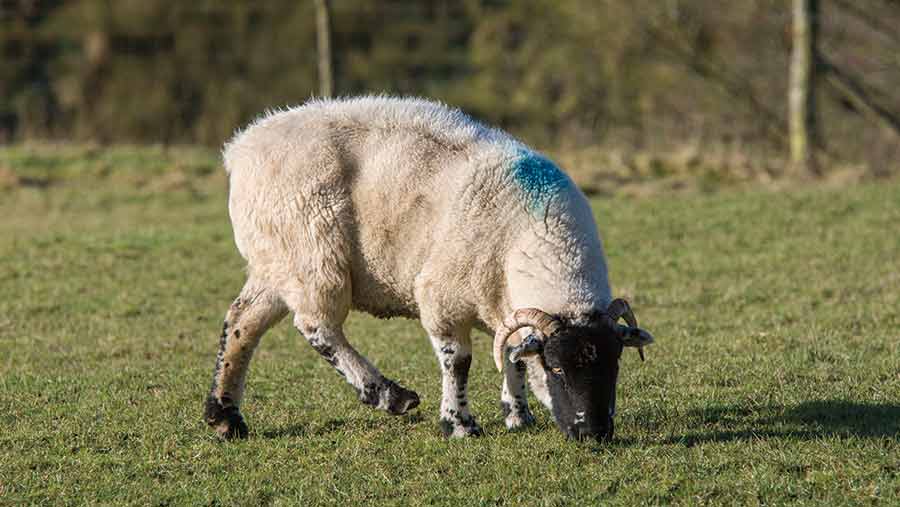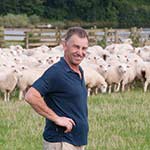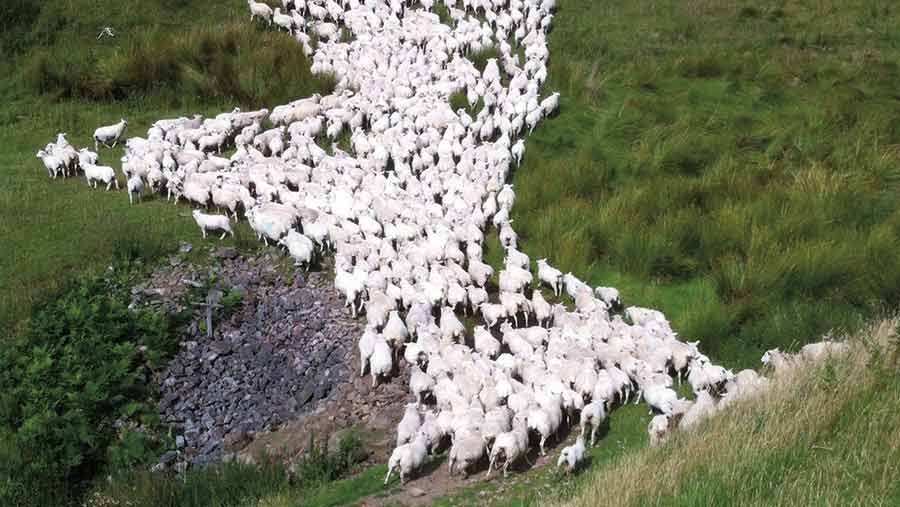Industry support needed to get sheep lameness below 2%
Sheep lameness prevalence is recorded at below 5% in the UK, but the focus has switched to meeting the Stamp Out Lameness campaign’s next target of 2% by 2021.
Ruth Clements, head of vet programmes at FAI Farms – a supporter of the campaign launched by Farmers Weekly in 2012 – is calling on the British sheep sector to build on the momentum of the campaign’s success.

© John Eveson/FLPA/Rex/Shutterstock
See also: More information on tackling sheep lameness
Launched in association with MSD Animal Health and supported by FAI Farms and the National Sheep Association (NSA), the Stamp Out Lameness campaign sought to help the British sheep industry meet recommendations to cut lameness within flocks to 5% or less by 2016 and 2% or less by 2021.
Four years since the launch of the campaign, prevalence is falling and is on course to meet the 2021 target.
“There is some data on prevalence,” says Ms Clements. “It has some limitations, but it shows we are currently at about 4.9%.
The five-point lameness plan
- Culling badly or repeatedly infected animals
- Quarantining incoming animals
- Prompt treatment of clinical cases
- Avoid spread at handling and gathering
- Vaccination
“We have achieved this first target. But at 5%, we still don’t have control. We will only have real control when we achieve 1% or less,” she says.
Ms Clements says the key to tackling the disease is to implement all the actions of the five-point plan (see right).
“The really innovative farmers have taken it on, but we are always going to have those farmers that need extra help to do that,” she says.
Industry support is also crucial to the continued success of the campaign.
“We want this to be an industry initiative. Support hasn’t waned; the problem with delivering research at farm level is that there aren’t many funding streams, “ adds Ms Clements.
Government support – as has been seen in Wales – is important if the industry is to hit its 2021 target.
The Welsh programme, based on the five-point plan, is the first national lameness initiative, explains Ms Clements.
“Hopefully, we can use that as a springboard to set up initiatives in England and Scotland. If we can develop an industry-wide control plan, we are likely to have a good chance of tackling this.”
Case study
Kevin Stewart, Cheviots, Scotalnd

Kevin Stewart ©Hector Innes
With only himself and an apprentice looking after 2,600 ewes on three different upland units across 500ha on the edge of the Cheviots in south Scotland, Kevin Stewart doesn’t have the time or labour available to treat lame sheep.
That’s why disease prevention is the name of the game for Mr Stewart, who runs 1,200 Highlander ewes at Linton Burnfoot Farm, another 1,000 at Gattonside, 400 draft ewes at Springhall and a flock of 70 pedigree Suffolks from his Sharpitlaw base near Kelso.
The flock is a multiplier for Innovis and sells between 70 and 100 Suffolk and Highlander rams each year.
“I hate to see lame sheep and frankly, we couldn’t farm sustainably if we did have lameness or any other underlying disease problem to manage,” says Mr Stewart.
Preventative approach keeps feet sound
“We invest in a partnership with Galedin Vets and follow our flock health plan closely, which puts the focus firmly on preventing disease issues and keeping our sheep healthy and productive.
“This approach certainly helps us to get on top of any issues quickly if they do occur and, as a result, we seldom need a vet visit to treat any sick animals.”

Sheep are moved regularly
With the ground he farms mainly enclosed by woods and roads – and the fact that he only bought in four sheep last year – disease management odds are tipped in his favour compared with many flocks.
But there is much that can be learned from his sheep farming philosophy.
“We do jealously guard our borders and we are fortunate that we are able to run a pretty much closed flock.
“I always say our aim each year is to buy nothing and sell a lot. But to do the job well and make a decent living, we can’t afford any preventable disease issues compromising optimal flock output.”
Mr Stewart routinely vaccinates against clostridial diseases, pasteurellosis and the infectious causes of abortion.
Five-point plan
Lameness issues are kept to a minimum thanks to a good sheep-handling system that helps minimise the spread of any foot infections that may be present in the flock, on-going vaccination against footrot, and prompt, appropriate antibiotic treatment of the few cases that do present.
These are three of the cornerstones of the industry-accepted five-point sheep lameness reduction plan. Culling persistent offenders and quarantining any bought-in sheep are the other key points.
Ewes and tups are vaccinated in the autumn, meaning Mr Stewart only tends to see lameness in lambs, but cases “are few far between”, he says.
Mr Stewart has had first-hand experience of how bad lameness can get in a flock and he’s not prepared to compromise.
“I managed another sheep unit that initially had lots of lame sheep on it and it was a real headache. But persistent offenders were culled hard, the rest of the flock was vaccinated and within a year their feet were sound,” he says.
Highlander ewes
The Highlander ewes at Linton Burnfoot go to a Suffolk tup in November and start lambing on 16 April. They are winter shorn and housed at the beginning of January and fed a silage-based pre-lambing diet.
They then go out in the second week of March, when feed blocks are introduced, and they lamb at grass.
Yearling ewes and any carrying triplets stay inside to lamb. The lambs are reared off grass on a rotational grazing system and either sold as stores or kept as flock replacements.
“Our rotational grazing also helps us keep feet sound over the summer because sheep aren’t on the same ground for long.
“If you do have infection in the flock it can spread quickly, particularly if a lot of sheep spend lengthy periods on contaminated fields.
“We can have 300 ewes plus lambs in one field, but they do move on every three or four days.
“Our handling facilities are also good and can accommodate lots of sheep on dry, clean concreted hard-standing in a covered yard, which also helps,” Mr Stewart says.
The Gattonside flock, which is put to a terminal sire, lambs 10 days later. Gattonside is also home to the Suffolk flock. At Springhall, older draft ewes from the other two farms are lambed in March and spend their final year on the unit before being culled in June.
“There’s no doubt in my mind that disease prevention must be the way forward for the sheep industry,” Mr Stewart says.
“Invest in a partnership with a good vet who understands sheep farming and you will reap the financial dividends.
“You will also spend far less time gathering and handling sheep, which means a lot less stress all round. It certainly works for us.”
